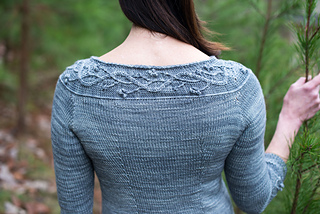patterns >  Wood House Knits and 1 more...
Wood House Knits and 1 more...
> Winterberry














Winterberry
I love the stark beauty of the bare branches against the winter sky or their shadows on a moonlight winter walk. The berries and dried flowers are hanging on with a dogged determination during the winter winds. It reminds me that beauty and grace can still be found in the bleak of winter or in the dark times in out lives. That is what inspired the cable pattern in Winterberry that wraps around the yoke then spreads across the front.
There are 3 shaping options below for this pattern.
- Form fitting.
- Ease in the bust and an A-line body.
- A tunic style with plenty of ease. (Shown in red)
To get a discount for future releases sign up for my newsletter here!
Sizes:
Finished bust: 29.25 (32.25, 35.25, 38, 41.25, 44, 47, 50.25, 53.25, 56.25, 59)“. Size 32.25” modeled with 2” negative ease.
Materials:
Yarn: Anzula Cricket, 80% merino wool, 10% nylon, 10% cashmere; 229m (250 yds) per 114g skein; color: Hippo, 4 (4, 5, 5, 6, 6, 7, 7, 7, 8, 8) skeins, 959 (1000, 1156, 1230, 1372, 1477, 1543, 1705, 1750, 1860, 1918) yds.
Needles: Size 3/3.25mm 24” circular needles and set of 4 or 5 double-pointed needles.
Other: Stitch markers, cable needle, waste yarn, tapestry needle.
Gauge: 22 sts and 30 rows = 4” in Stockinette Stitch.
Notes:
This rounded yoke pullover is constructed from the top down in one piece with raglan increases to shape the bodice. The yoke band is worked sideways, then the stitches are picked up along the edge for the yoke. To create a flattering fit there are short rows to shape the back neckline higher than the front. This pullover is designed with negative ease in the bust, but with a looser fit in the back and hips. The back decreases do not change the circumference of the sweater, they balance out the increases worked in the chart. For fit obtains check the notes at the end of pattern by the schematic.
For this design I used two different methods of short rows. I used the German method of short rows for the yoke band which are incorporated into the chart, and the wrap and turn method for the short rows that are worked in the yoke. You may use the short row method of your choice.
3307 projects
stashed
2889 times
- First published: March 2016
- Page created: March 21, 2016
- Last updated: April 3, 2019 …
- visits in the last 24 hours
- visitors right now




